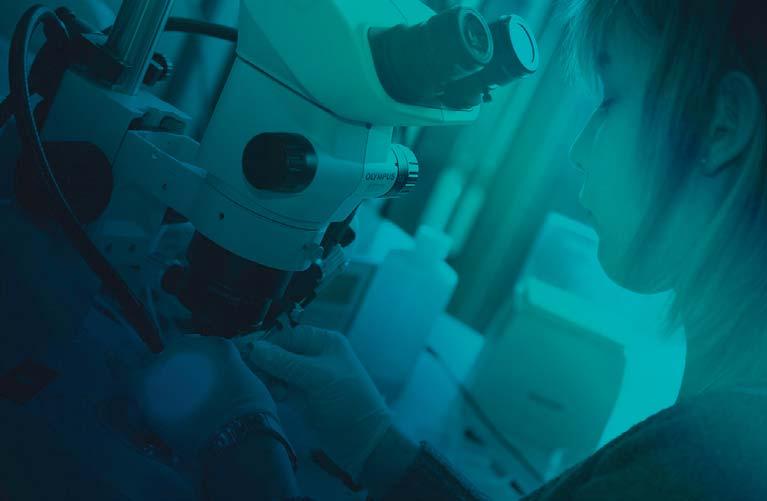I
n
n
Green chemistry applied to polymers for coatings, biomaterials, and more! As an integral part of CESAM (Complex and Entangled Systems from Atoms to Materials) research unit of the University of Liège, the CERM develops proven expertise thanks to the academic strength of its 30 researchers. Its platform dedicated to the valorization of CO2 is unique in Europe.
W
used at present. The CERM also involves itself in projects related to the implementation of biomaterials which have already passed clinical tests, as well as the development of new processing methods such as electrospinning and 3D printing to design scaffolds stimulating cellular regeneration or various medical implants. Finally, the CERM goes into greater depth on the green technology of supercritical CO2 to design sterile medical devices (suture threads or implants) with anti-inflammatory properties.
The CERM enjoys a wide range of research partnerships, starting at European level with the Marie Curie programs, RENAISSANCE and EJDFunMat, dealing with the development of environment friendly materials. It is also very active in the field of biomaterials. In this context, it participates in the ERC “PV-Coat” European project on the coating of heart valves and in the INTERREG PolyValve project targeting the development of new materials for heart valves. It is also developing innovative degradable polymers, notably within the IN FLOW project that is devoted to the developPolymer implants for vaginal, ment of continuous flow technologies for the design cardiac and ophtalmic applications of biodegradable materials and formulations for food, pharmaceutical and biomedical applications. In addition, the CERM cooperates with various Belgian universities, especially through its participation in the EOS programme via the fundamental research project “Bio-based Factory”, which started in 2018 and focuses on merging sustainable chemistry from lignin and CO2. The CERM can capitalize on important industrial partnerships with Solvay, Solvin, ArcelorMittal, Saint-Gobain, UCB, Dupont, Bayer, KURARAY, and a great number of SMEs. Particularly, the CERM coconceived a patent intended for the development of a biomedical implant eluting a contraceptive agent (the patent is being exploited by Mithra), it ensured the reparation of one of the components of intraocular yellow lenses produced by PhysIOL, develops new hydrogel-based medical devices for Dermax (now in the clinical development phase) and elaborates new trends for future products on the basis of patents against royalties. Incidentally, the CERM initiated startups such as EyeD Pharma, based on the development of drug-eluting implants for ocular pathologies.
© CERM
ith its unique expertise in polymer chemistry, the CERM produces some thirty-five publications and two patent registrations per year. It specializes in the synthesis of polymer materials along two main lines: the development of innovative materials (by controlled radical polymerization, ring-opening polymerization, step-growth polymerization); the development of polymers more respectful of the environment by valorizing CO2 – with a unique platform in Europe that allows synthesis, foaming, extraction and polymer impregnation in the sector of functional coatings, foams and biomaterials.
Doubtless, the CERM stands well equipped and ready to address the five major challenges which confront it. From developing synthesis techniques to implementing greener processes (organocatalysts, solvent-free processes, chemical reactions based on atom economy), to help advance chemistry, and develop polymer materials for energy or multifunctional coatings with aqueous processes or without solvents, or develop competitive biomaterials, the CERM seizes upon any opportunity to deepen and make relevant its expertise.
© CERM
o
v
a
t
i
o
n
T e
c
h
n
o
l
o
g
y
Center for Education and Research on Macromolecules - CERM
CO2 self-blown non-isocyanate polyurethane foams
Center for Education and Research on Macromolecules (CERM) Université de Liège (ULiège) Institut de Chimie (B6a)
The CERM currently remains involved in seven collaborative research projects, two of which concentrate on the development of a new kind of chemistry to synthesize polyurethanes and polycarbonates from CO2, obtained from and with a lower degree of toxicity on the environment, in comparison to the molecules
Agora, Allée du 6 Août, 13 - 4000 Liège Tel: +32 (0)4 366 34 91 - Fax: +32 (0)4 366 34 97 Email: c.jerome@uliege.be - http://www.cerm.ulg.ac.be/ 146

















































































































